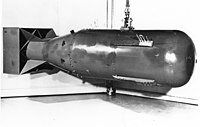
Photo from wikipedia
Abstract At the Kyoto University Critical Assembly experiments on kinetics parameters are carried out at near-critical configurations, supercritical and subcritical states, in the thermal neutron spectrum made with a highly… Click to show full abstract
Abstract At the Kyoto University Critical Assembly experiments on kinetics parameters are carried out at near-critical configurations, supercritical and subcritical states, in the thermal neutron spectrum made with a highly enriched uranium fuel. The main calculated kinetics parameters, the effective delayed neutron fraction (βeff) and the neutron generation time (Ʌ), are used effectively for the estimation of experimental parameters, and the accuracy of experiments on prompt neutron decay constant (α) and subcriticality (ρ$) in dollar units is attained by the numerical results of βeff and Ʌ. Furthermore, the value of βeff/Ʌ is experimentally deduced with the use of the experimental results of α and ρ$, ranging between 250 and −80 pcm. Thus, the experimentally deduced values of βeff/Ʌ that reveal good accuracy through a comparison with those by the MCNP6.1 calculations with JENDL-4.0 are then taken as an index of Ʌ by introducing an acceptable assumption of βeff at near-critical configurations. From the results of experimental and numerical analyses, the experimental value of βeff/Ʌ is important for the validation of Ʌ since kinetics parameters are successfully obtained from the clean cores of near-critical configurations in the thermal neutron spectrum.
Journal Title: Nuclear Science and Engineering
Year Published: 2020
Link to full text (if available)
Share on Social Media: Sign Up to like & get
recommendations!